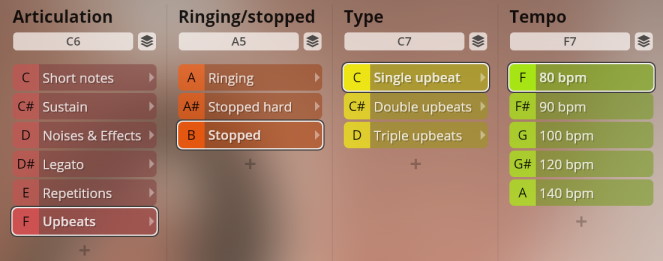SYNCHRON-ized Plucked Instruments
Introduction
Welcome to the Vienna Symphonic Library's series of Synchron Instruments! SYNCHRON-ized Plucked Instruments was specifically created to enrich the tonal palette of your Synchron Instruments with the inimitable sound of our concert guitar, overdrive guitar, and upright bass recordings. This document will provide you with the information you need to use the Library with our Vienna Synchron Player.
For creating SYNCHRON-ized Plucked Instruments, our sound editors went back to the raw, unprocessed sample data of the Libraries contained in our Plucked Instruments Bundle. The original recordings were completely re-edited and re-mastered in order to achieve an all-new, modern sound that excels in terms of aesthetics, playability and realism, and that is optimized for use alongside the Synchron Series instruments.
About Presets
For SYNCHRON-ized Plucked Instruments, our software developers added a specifically designed convolution reverb derived from Vienna MIR Pro to the Synchron Player, featuring the outstanding and unique ambience of the 540 m2 (5,813 sq.ft.) main hall of Synchron Stage Vienna. The perfectly engineered reverberation and placement presets combine customized impulse responses with expertly crafted reverb settings for each group of the ensemble. By adding the ambience of Synchron Stage Vienna's Stage A to the dry samples in real-time, SYNCHRON-ized Plucked Instruments now perfectly blend with any other product of our Synchron Series.
For each instrument, there also are Mixer Presets that depict different recording situations, and allow you to adapt the behaviour of your instrument to the context of your setting, be it as a solo instrument or in a large orchestra. In addition there is also a special FX Preset section that offers even more creative possibilities.
Sound Categories
The Presets of each instrument are subdivided into different Articulation categories, ready for your own creations:
Concert Guitar
- Short notes
- Long notes
- Long specials
- Legato
- Repetitions
- Fast repetitions
- Phrases
- Effects
- Chords
Overdrive
- Short notes
- Long notes
- Harmonics
- Tremolo & trills
- Grace notes
- Power chords
- Effects
- Legato
- Repetitions
- Fast repetitions
- Scale runs
Upright Bass
- Short notes
- Sustain
- Noises & effects
- Legato
- Repetitions
- Upbeats
Within these Articulation categories, you can select different types – e.g., short notes staccato or portato. For some of the types there are additional options available, such as "ringing" or "stopped" sustains with or without vibrato.
About Patches
Patches can be used to build your own custom Presets and adapt the Synchron Libraries to your specific requirements. For further information on constructing Presets, please see the Synchron Player manual.
About Pitch
For designating pitch, the Vienna Symphonic Library uses International Pitch Notation (IPN), which was agreed upon internationally under the auspices of the Acoustical Society of America. In this system the international standard of A=440 Hz is called A4 and middle C is C4. All pitches are written as capital letters, their respective octave being indicated by a number next to it. The lowest C on the piano is C1 (the A below that is A0), etc.
The Synchron Player software allows you to set middle C to C3, C4, or C5 according to your preference. Selecting another setting than C4 will of course also change the play ranges and keyswitches accordingly.
Walkthrough Videos
Included Presets
The instrument Presets comprise all recorded Patches in Articulation groups, which again contain Types of the respective Articulation, with further options if available. The general structure was modeled after our other Synchron Collections, making it easy to switch or combine instruments without major adaptations.
The default installation path of your Plucked Instruments Collection in your specified harddisk or folder is "..\35 SYzd Plucked Instruments". In the Synchron Player, you will find this under the heading "SYNCHRON-ized Collections".
Articulations are enabled by default. Disabling a slot means that all the slots dependent on it will be deactivated, too, so if you happen to be short of RAM it is possible to deactivate anything you don't really need (you can always add more stuff later).
By default the mapping of keyswitches for Articulations starts at C1 (for Middle C = C4) for higher instruments – in this case, concert and overdrive guitar –, and C6 for bass instruments – here, the upright bass. Other slot categories, e.g., release type, vibrato, etc., use keyswitches or dimension controllers such as the modwheel or playing speed.
01 Concert Guitar
Articulation groups
- Short notes
- long notes
- long specials
- legato
- repetitions
- fast repetitions
- phrases
- effects
- chords
Range: D2–C6 unless indicated otherwise
Short notes
Staccato A and B, Bartók staccato, étouffé staccato, and hammer staccato.
- Type keyswitches: C7–E7
- Range: étouffe D2–E5; hammering F2–A#5
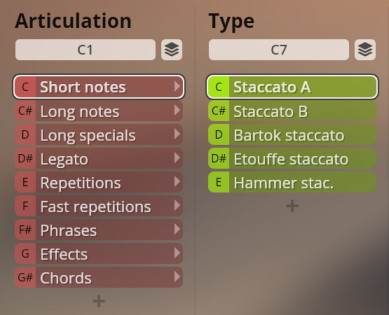
Long notes
Sustained, flautando, ponticello, and Bartók (snapping).
- Keyswitches
- Ringing/stopped: A0/B0
- No vibrato/vibrato: F6/F#6
- Articulation type: C7–D#7
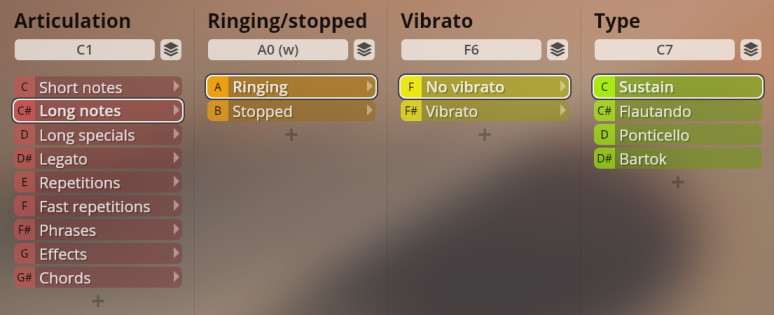
Long specials
Étouffé ('choked'), hammered, artificial harmonics, and natural harmonics low and high.
- Keyswitches
- Ringing/stopped: A0/B0
- Articulation type: C7–E7
- Range
- hammered F2–A#5
- artificial harmonics D3–B6
- natural harmonics low C3–A6, high C3–A5
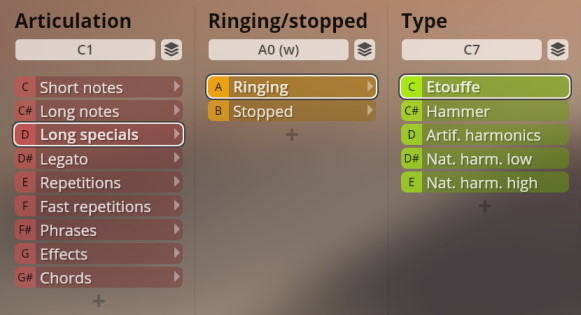
Natural harmonics mapping
The mapping for each string starts at C, beginning with low E tuned down to D.
- C: Octave
- D: 5th (plus octave)
- E: 2nd octave
- F: major 3rd (+ 2 oct.)
- G: 5th (+ 2 oct.)
- A: 3rd octave
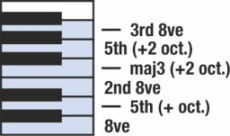
Legato
Performance legato, ponticello, glissando, and hammered/pulled transitions.
- Keyswitches
- Ringing/stopped: A0/B0
- Articulation type: C7–D#7
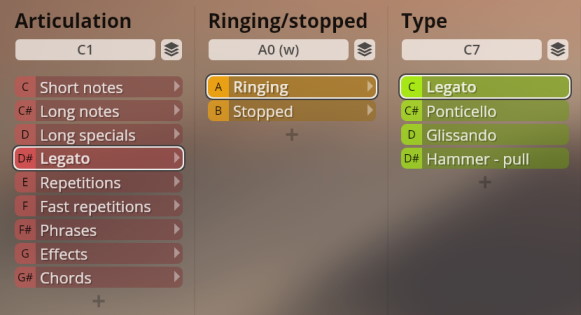
Repetitions
Regular repetitions slow, medium, fast, crescendo, and diminuendo, and ponticello repetitions slow and fast.
- Keyswitches
- Ringing/stopped: A0/B0
- Regular/ponticello: F6/F#6
- Articulation type: C7–E7
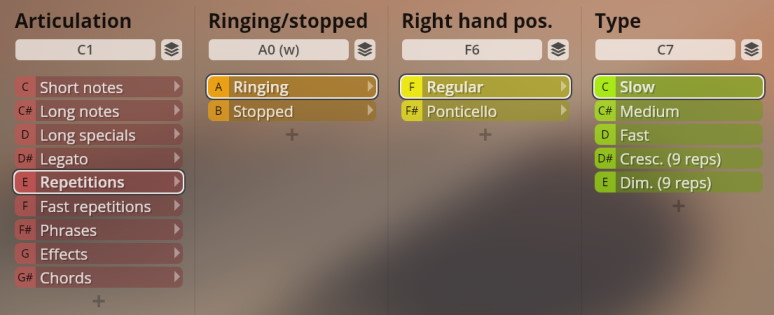
Fast repetitions
Fast repetitions, 140 to 200 BPM, regular and ponticello.
- Keyswitches
- Ringing/stopped: A0/B0
- Regular/ponticello: F6/F#6
- Tempo: C7–E7
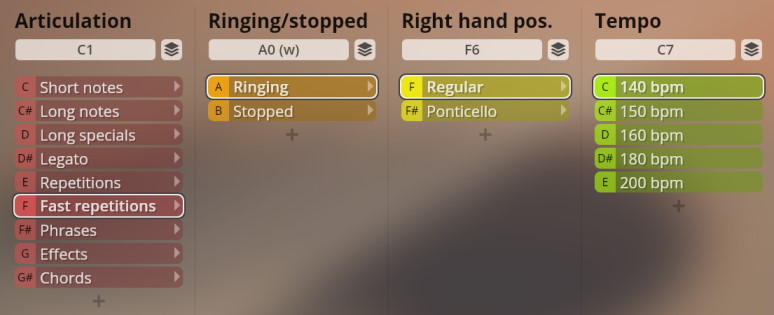
Phrases
Tremolo, half and whole tone trills, bends up and down.
- Keyswitches
- Ringing/stopped: A0/B0
- Articulation type: C7–E7
- Range
- trills D2–F5
- bends D#2–B5
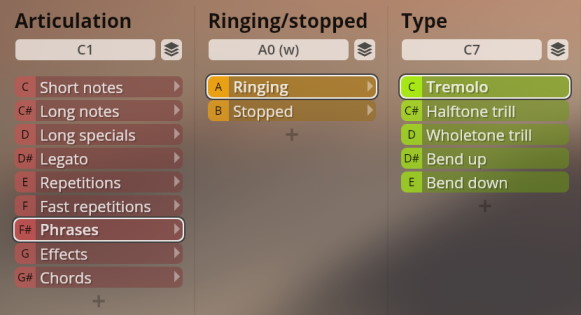
Effects
Harp, golpe, muted chord strokes, tambora (thumb strokes), and scratching on the E, A, and D strings.
- Effect type keyswitches: C7–F#7
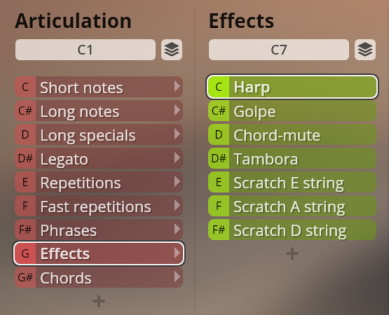
Harp mapping
Harp-like effects created by plucking the strings between the nut and the tuners.
- Range: C3–F6

Golpe mapping
Strokes on the top, side, neck, fingerboard, flams and fingernail strokes on the bridge of the guitar, and drum rolls.
- Range: D2–D6

Chord-mute mapping
Battente, pulled, short and long rasgueado, and arpeggio.
- Range: C4–G4
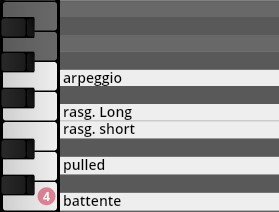
Scratches mapping E string
Scratching on the low E string.
- Range: C3–A#6

Scratches mapping A string
Scratching on the A string.
- Range: C3–A#5
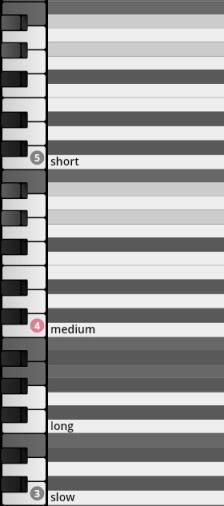
Scratches mapping D string
Scratching on the D string.
- Range: C3–A#5
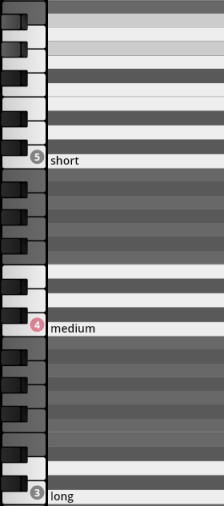
Chords
Chords in all keys, major, major 7, minor, minor 7, and chromatic mappings for various chords.
- Keyswitches
- Right hand technique: A1–C2 regular/ rasgueado/ rasgueado rolls/ arpeggio
- Ringing/secco/stopped: A0/A#0/B0
- Tonal mode: F6–A6
- Key: C7–B7
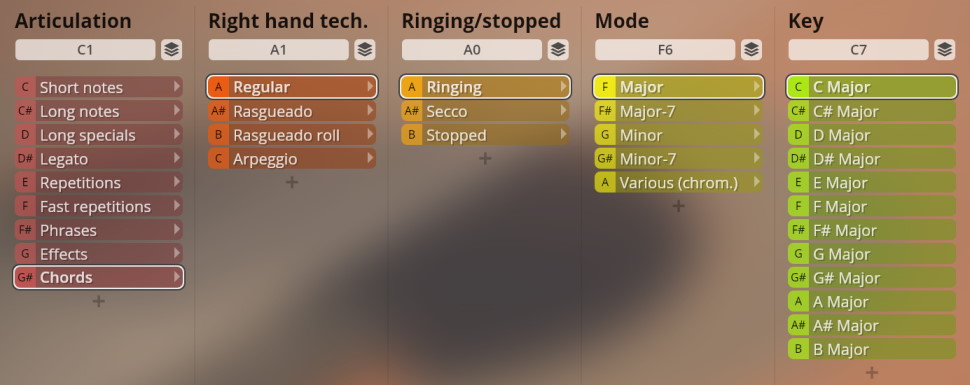
Mapping
E2–D#4 features the lower playing positions on the guitar with 3–4 6-string chords and 1–3 5-string chords followed by 4-string chords up to the highest chord.
E4–G5/G#5 (depending on the scale) features higher playing positions, with 6-string chords up to C3, if possible. The lowest of these are the same in playing position 1. They are followed by 5-string chords up to G3. The following 4-string chords are the same as at the 1st playing position.
Major
3-key chords on every note of the scale, C major to B major, played on 4 to 6 strings depending on tablature. Here's an illustration of the chords as played for C major, with the keys they are mapped to.
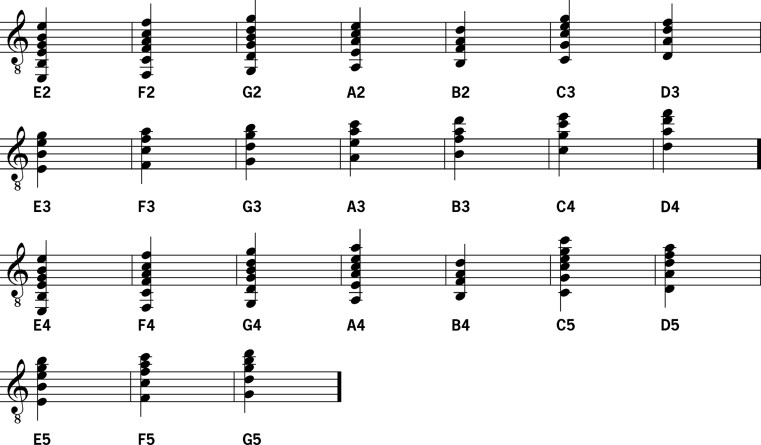
Major-7
4-key chords on every note of the scale, C major to B major, played on 4 to 6 strings depending on tablature. Here's an illustration of the chords as played for C major, with the keys they are mapped to.
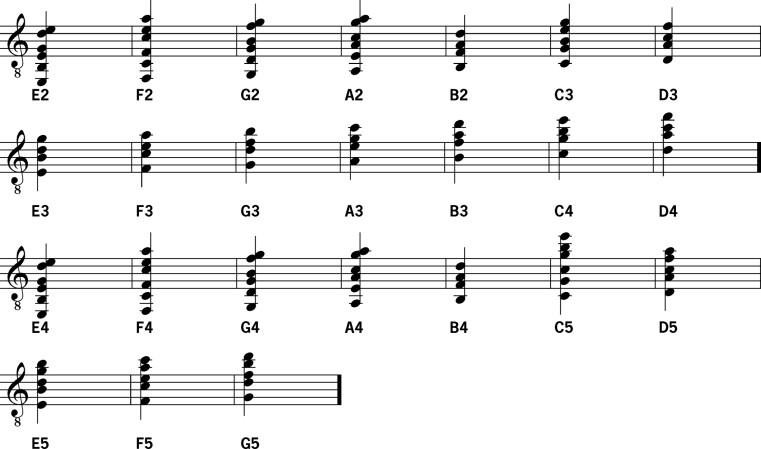
Minor
1st playing position, E2–D#4: aeolian mode (natural minor).
2nd playing position, E4–D6/D#6: harmonic minor.
Here's an illustration of the chords as they are played for C minor, with the keys they are mapped to.
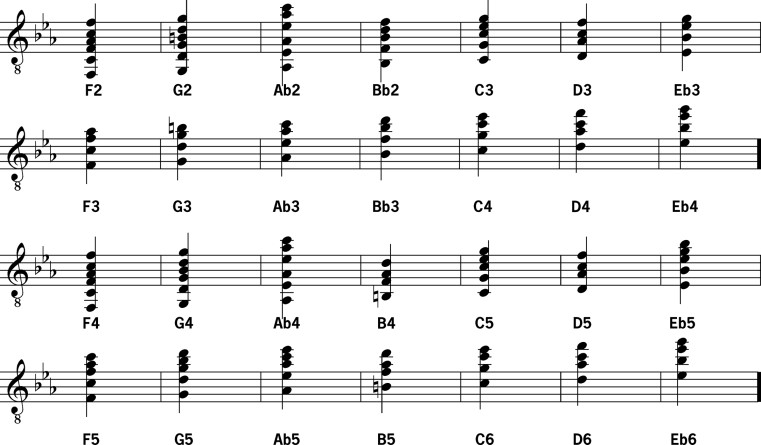
Minor-7
1st playing position, E2–D#4: aeolian mode (natural minor).
2nd playing position, E4–D6/D#6: harmonic minor.
Here's an illustration of the chords as they are played for C minor, with the keys they are mapped to.
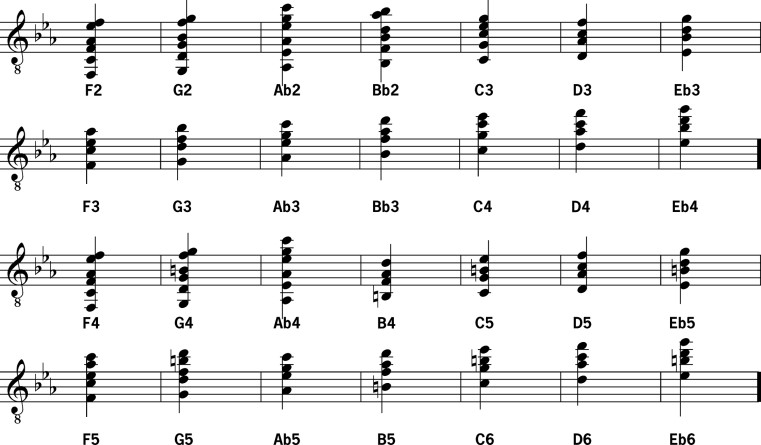
Various (chromatic)
Major, minor, dominant 7, major 7, and minor 7 chords on 6, 5, and 4 strings
Diminished 7, major 7 with augmented 5th, minor 7 with diminished 5th, and minor with major 7th chords
Sus4 and 7sus4, with the E, A, and D strings as base.
Here's an illustration of the chords, based on the lowest playing position on the guitar.
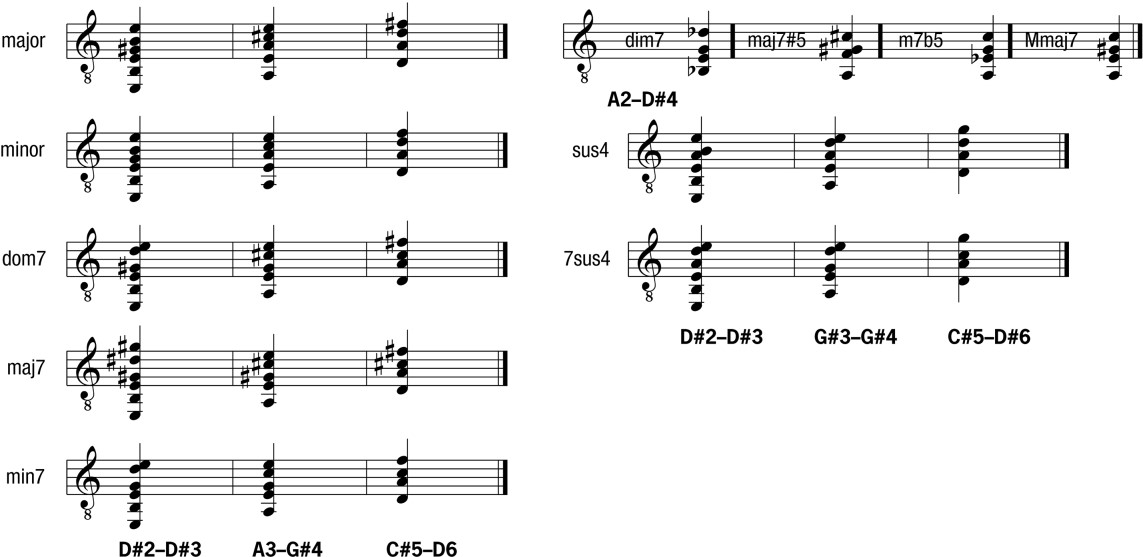
Chord play ranges
Range Major 3 and 4 keys
- C major: E2–G5
- C# major: F2–G#5
- D major: E2–G5
- D# major: F2–G#5
- E major: E2–G#5
- F major: E2–G5
- F# major: F2–G#5
- G major: E2–G5
- G# major: F2–G#5
- A major: E2–F#5
- A# major: F2–G5
- B major: E2–G#5
Range Minor 3 and 4 keys
- C minor: F2–D#6
- C# minor: E2–D#6
- D minor: E2–D6
- D# minor: F2–D#6
- E minor: E2–D#6
- F minor: F2–C#6
- F# minor: E2–D6
- G minor: F2–D#6
- G# minor: E2–D#6
- A minor: E2–D6
- A# minor: F2–D#6
- B minor: E2–D6
Range Chromatic mapping
- major: D#2–D6
- minor: D#2–D6
- dom7: D#2–D6
- maj7: D#2–D6
- min7: D#2–D6
- dim7: A2–D#4
- maj7#5: A2–D#4
- m7b5: A2–D#4
- Mmaj7: A2–D#4
- sus4: D#2–D#6
- 7sus4: D#2–D#6
02 Overdrive
Articulation groups
- Short notes
- long notes
- long specials
- legato
- repetitions
- fast repetitions
- phrases
- effects
- chords
Range: B1–D6 except where indicated otherwise
Short notes
Staccato short and regular, portato short and long.
- Note length keyswitch: F6–G#6
Staccato short, staccato, portato short
The staccatos offer variants with soft, medium, and hard attack.
- Staccato attack keyswitch: C7–D7
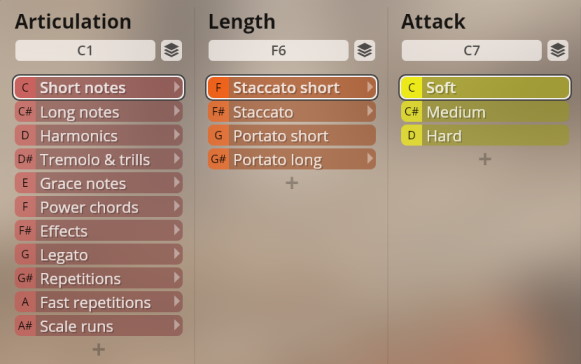
Portato long
Long portato with normal and hard release, with and without vibrato.
- Release keyswitch: A0/B0 release normal/hard
- Vibrato switch: Dim.Ctrl/A (CC1, Modwheel)
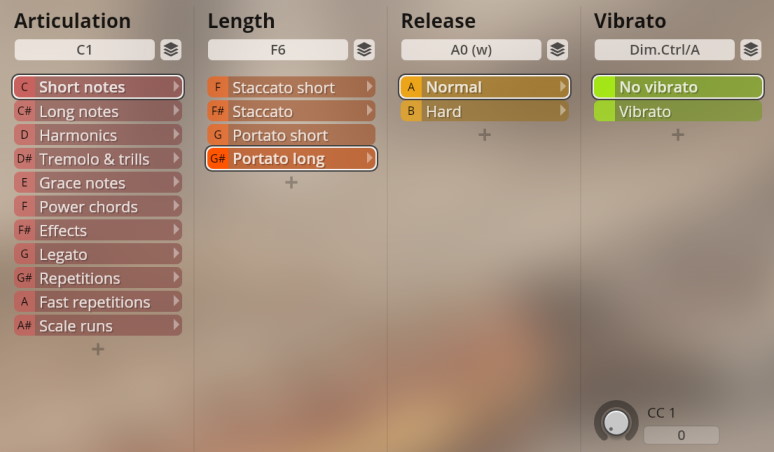
Long notes
Sustained notes without and with vibrato, as well as two variations of whammy bar action.
- Release keyswitch: A0/B0 release normal/hard. Vibrato switch: Dim.Ctrl/A (CC1, Modwheel).
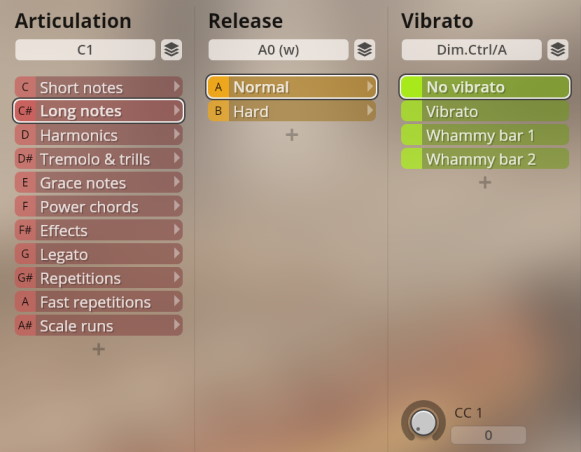
Harmonics
Artifical harmonics, fifth and octave with normal and hard release, and natural harmonics low and high.
- Keyswitches
- Release: A0/B0 normal/hard
- Type: C7–D#7
- Range
- Artificial fifths G3–C6
- artifical octave C4–F6
- natural low C2–A#5
- natural high C4–A#6
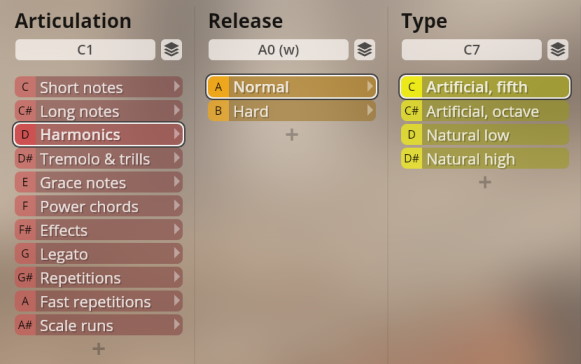
Natural harmonics mapping
low
- C2–A#2: low B string
- C3–A#3: low E string
- C4–A#4: A string
- C5–A#5: D string
high
- C4–A#4: G string
- C5–A5: high B string
- C6–A6: high E string
- C: Root
- D: Octave
- E: 5th (plus octave)
- F: 2nd octave
- G: major 3rd (+ 2 oct.)
- G#: 5th (+ 2 oct.)
- A: minor 7th¯ (+ 2 oct.)
- A#: 3rd octave
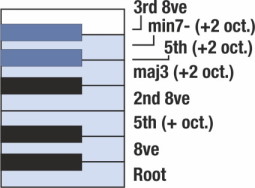
Tremolo & Trills
Tremolo, trills from minor 2nd to major 3rd, with normal and hard release.
Keyswitches
- Release: A0/B0 normal/hard
- Type: C7–E7
Trills range
- minor 2nd B1–C#6
- major 2nd, minor 3rd B1–C6
- major 3rd B1–A#5
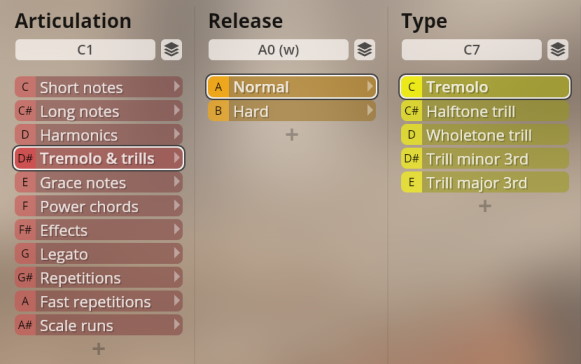
Grace notes
Grace noise, octave (harmonics), and whammy bar regular and octave.
Keyswitches
- Release: A0/B0 normal/hard
- Type: C7–D#7
Ranges
- octave E2–G5
- whammy bar B1–C#6
- whammy octave E2–C5
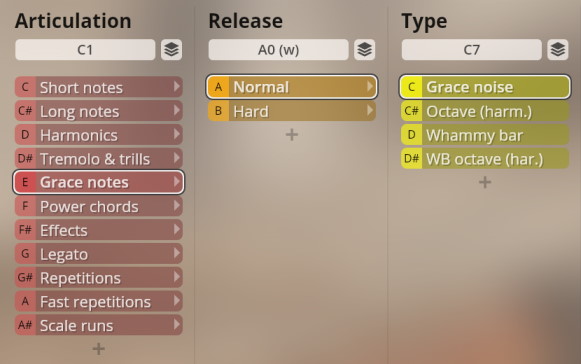
Power chords
Power chords, fourth, fifth, major and minor, with normal and hard release.
Keyswitches
- Release: A0/B0 normal/hard
- Type: C7–D#7
Range
- fourth B1–C5
- fifth B1–B4
- major, minor B2–F#4
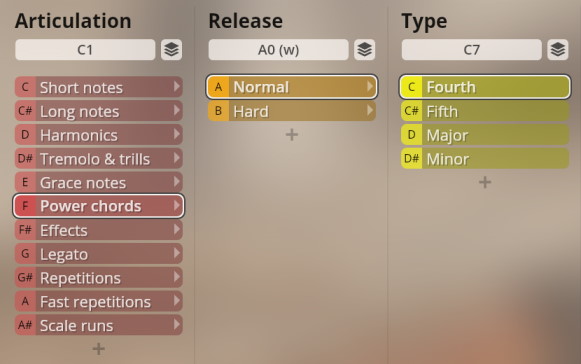
Effects
Feedback, soft and hard, E-bow, and tuned down, with normal and hard release. Scratching on the E and B strings, with whammy bar, and scratch effects.
Keyswitches
- Release: A0/B0 normal/hard
- Type: C7–G7
Range
- tuned down B1–D3 (the actual sounds are an octave lower than mapped)
- E string B2–A#5
- B string B1–G5
- whammy B2–A#3
- effects B2–F3
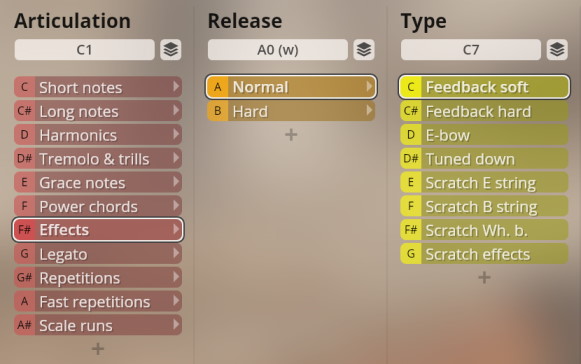
Legato
Legato bends, soft, hard, marcato, and hammered-pulled.
Keyswitches
- Release: A0/B0 normal/hard
- Transition: C7–E7
Range
soft, hard B1–C6
marcato, hammer-pull B1–C#6
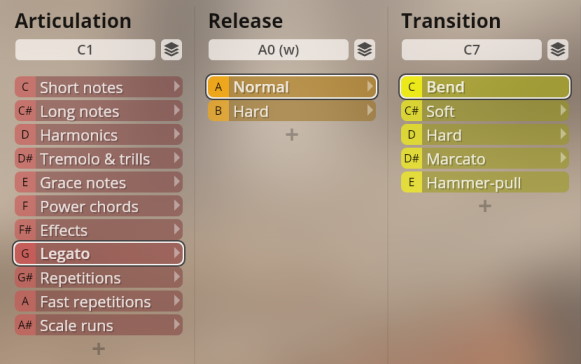
Soft, hard, marcato
These articulations offer variations without and with vibrato. Soft and hard also have two whammy bar variants.
- Vibrato switch: Dim.Ctrl/A (CC1, Modwheel)
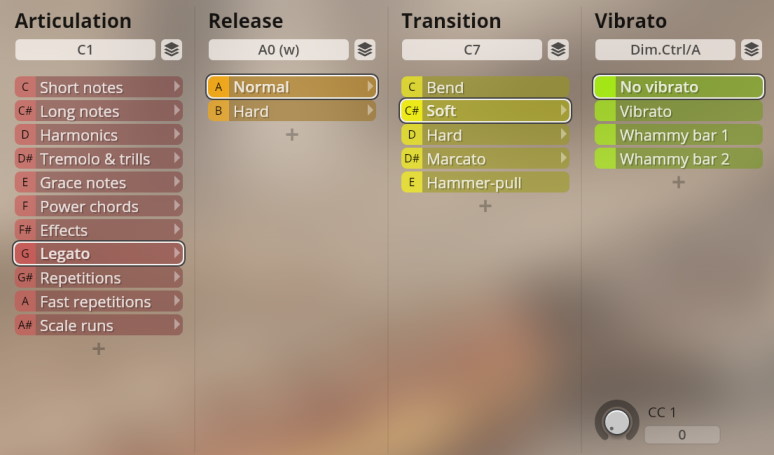
Repetitions
Single note and power chord repetitions.
- Single note/power chord keyswitch: A6/B6.
Single notes
Portato, crescendo, diminuendo, and muted with two variations each, as well as tuned down repetitions.
- Type keyswitch: C7–G#7
- Range
- portato, crescendo v.2, diminuendo v.2, mute B1–C#6
- tuned down B1–C3 (the actual sounds are an octave lower than mapped).
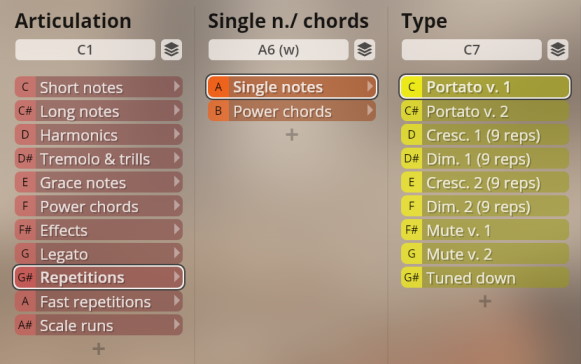
Power chords
Fourths and fifths repetitions, normal as well as crescendo and diminuendo.
- Type keyswitch: C7–F7
- Range: B1–C5
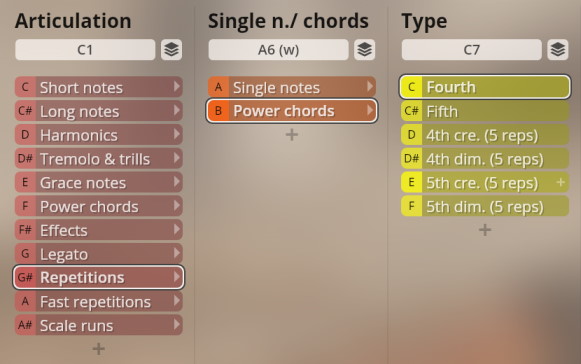
Fast repetitions
Fast repetitions steady, crescendo, diminuendo, and noise, from 140 to 220 BPM.
- Keyswitches
- Type: C7–D#7
- Tempo: F7–A#7
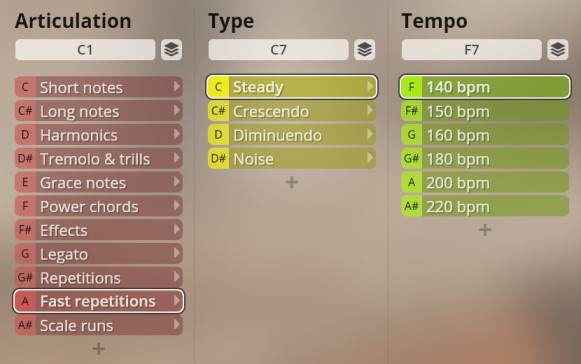
Scale runs
Octave runs, major and harmonic minor up and down, from C to B.
The runs are mapped to the notes of the respective key. Please note that the last playable note is an octave below the highest mapped note for upward runs, and an octave above the lowest mapped note for downward runs.
- Keyswitches
- Scale: F6–G#6
- Base key: C7–B7
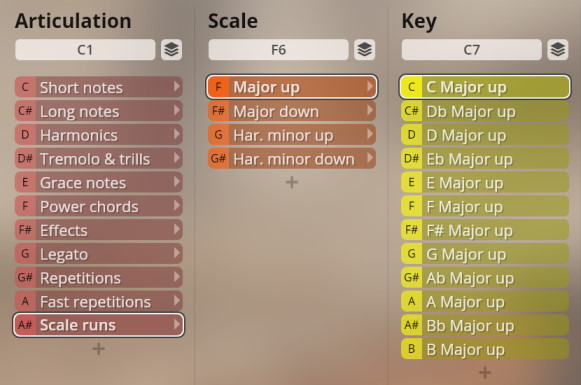
03 Upright Bass
Articulation groups
- short notes
- sustain
- noises & effects
- legato
- repetitions
- upbeats
Range: D1–G4 except where indicated otherwise.
Short notes
Staccato, portato short and long, damped, and muted.
- Type keyswitch: C7–F7
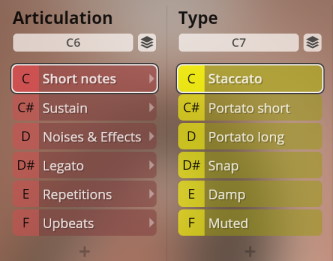
Sustain
Sustained notes ringing, stopped hard and normal, without as well as with light and medium vibrato.
- Keyswitches
- Ringing/stopped: A5–B5
- Vibrato: C7–D7
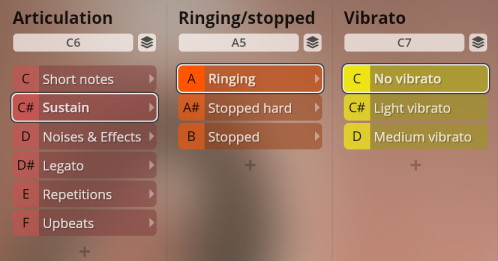
Noises & effects
Slides up and down, legato slides, finger stop, body noises, and sustained notes played with a bow.
- Type keyswitch: C7–F7
- Range
- slides up/down C2–F4
- finger stop D#1–G4
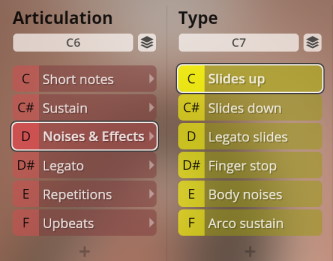
Slides up/down mapping
- C2–A#2: fast slides 1–8
- C3–A#3: medium slides 1–8
- C4–F4: slow slides 1–4

Body noises mapping
- C, D: single hits, l/r
- C#, D#: fast repetitions, var. 1/2
- F, G: performance repetitions, medium, var. 1/2
- F#, G#: performance repetitions, slow, var. 1/2
- C1–G#1: body hits, finger
- C2–G#2: body hits, knuckle
- C3–G#3: rib hits
- C4–G#4: fingerboard hits
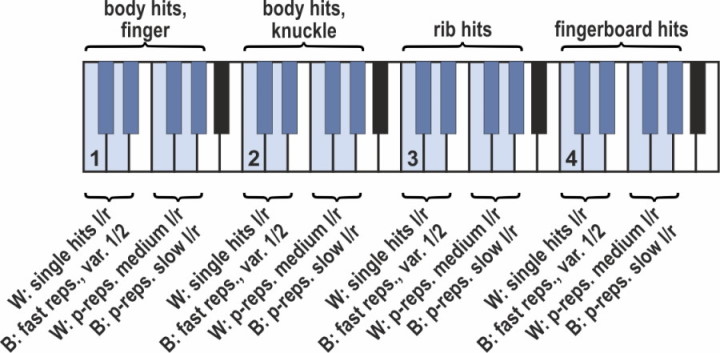
Legato
Legato, ghost notes, glissando, and slow glissando, ringing, stopped hard and normal, without and with slide noise.
Keyswitches
- Ringing/stopped: A5–B5
- Type: C7–D#7
Slide noise switch: Dim.Ctrl/B (CC1, Modwheel)
No Slide
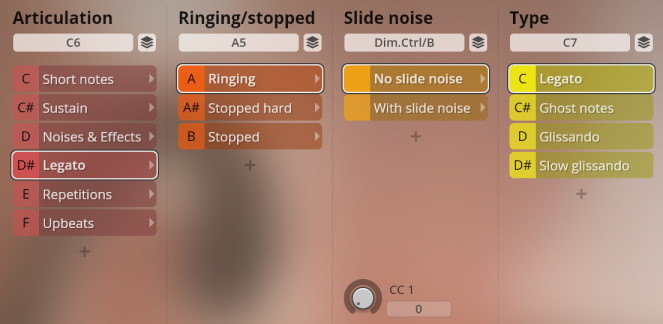
Slide
Use Dim.Ctrl/A (CC3) to adjust the noise amount of the slides.
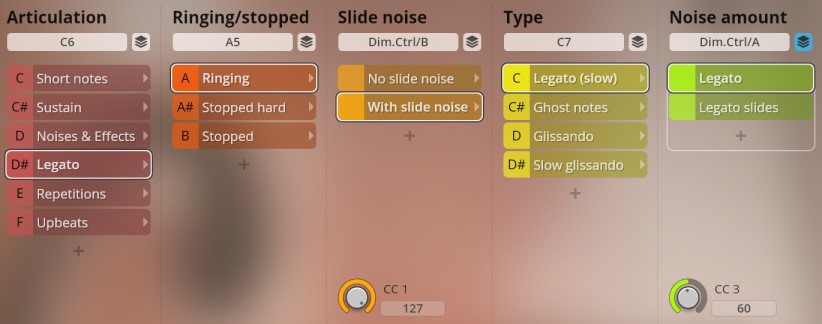
Repetitions
Repetitions ringing and stopped hard without and with vibrato, and stopped normal.
- Ringing/stopped keyswitch: A5–B5
Ringing, stopped hard
- Vibrato keyswitch: C7/C#7
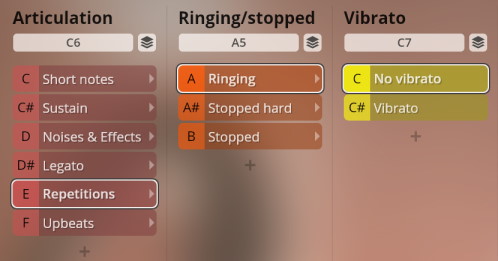
Stop normal
Slow without and with vibrato, portato slow and fast, and autospeed.
- Type keyswitch: C7–E7
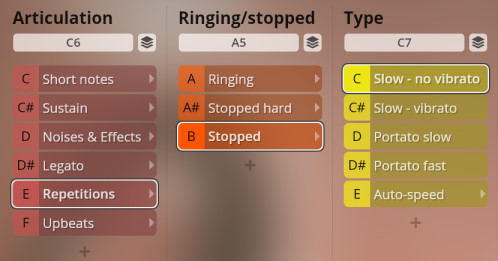
Autospeed
This slot uses Dim.Ctrl/D (playing speed) to switch automatically between slow notes without vibrato, slow portato, and fast portato.
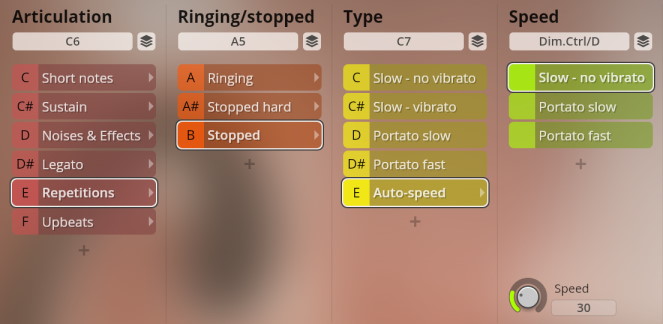
Upbeats
Single, double, and triple upbeats at 80/90/100/120/140 BPM.
- Keyswitches
- Ringing/stopped: A5–B5
- Type: C7–D7
- Tempo: F7–A7
